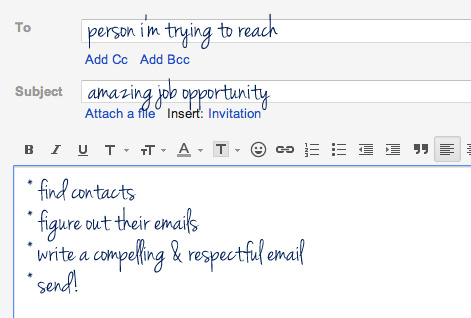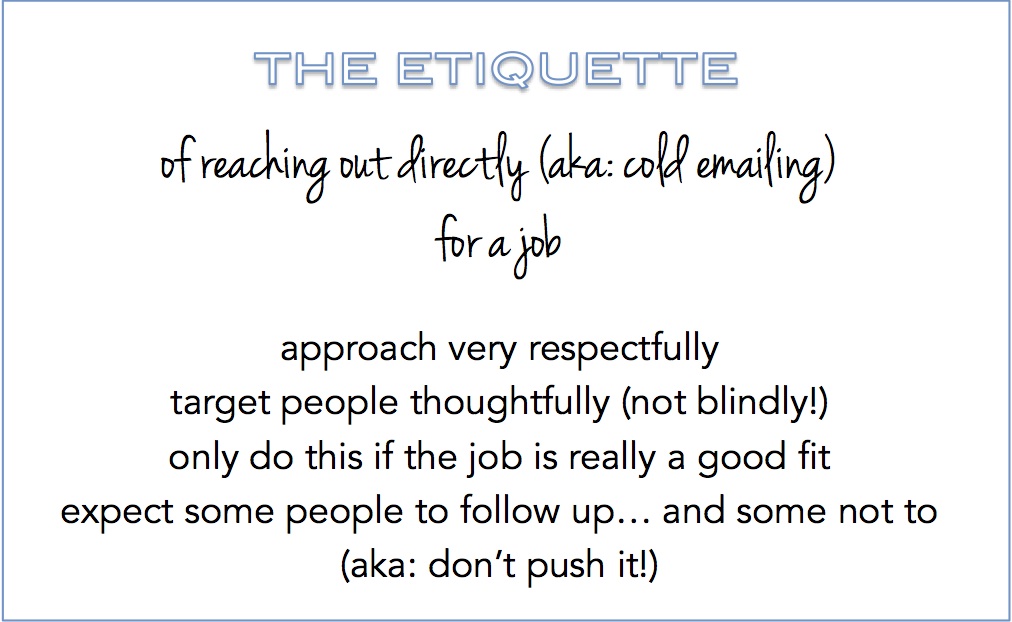I think everyone out there has a genuine fear of the “resume black hole” – the place where resumes go never to be found. I can say with confidence that this is not always true. I’ve personally reviewed thousands and thousands of resumes that have come through online… but whether or not your application gets seen does depend on the company, the job, and lots of other factors.
That’s why I always advise people to reach out directly IF they are actually qualified for the job and genuinely excited about it. But what if you don’t have a contact at the company? Which raises the question…
What’s the best way to email someone you don’t know about a job? And should you do it?
There are a few different strategies for reaching out directly (phone calls, popping into the office, sending snail mail) but the one I think is the most effective (check out this success story) is reaching out directly by email (aka: “the cold email”).
This won’t guarantee that you will get called in for an interview, but it does almost guarantee that your resume will at least be seen, by someone, at the company.
You may be thinking, how can I even find an email address for someone I don’t know? And what would I write? We have some answers…

STEP 1
Research via LinkedIn and find some ideal contacts – If you are applying for a PR job, this might be some high level PR professionals within the company. In general it’s always good to find someone on the recruiting team as well. Most of the time (as long as you are connected through a few degrees and their privacy settings are set to the standard) you will be able to see a first and last name which is exactly what you’re looking for. Some people, especially recruiters, may put their email right up on their profile.
STEP 2
Figure out the “naming convention” of their email address – This is the toughest part of figuring out an email but there are only so many possibilities. If you are emailing John Doe at Apple, his email will probably either be john@apple.com, jdoe@apple.com, johndoe@apple.com, john_doe@apple.com, doe.john@apple.com or some other common variation. Think of all the different possible combinations and make a list.
STEP 3
Figure out the rest of their email address – the second part of the email address is the part that comes after the @ sign. Let’s take an example of John Doe who works at Apple. If his email is johndoe@apple.com, this is the part where we are figuring out the @apple.com. Most companies have their “support” or generic emails published on the “contact us” page. For example, if press inquires are directed to press@apple.com, then there you have it! In other cases (like this one) it is pretty obvious what the last part of the email will be.
STEP 4
Write your email – The body of your email should essentially be a short version of your cover letter (and replaces the cover letter). Write about who you are, what you’re currently doing, any relevant past experience, and why you are interested in the X job at their company. Your resume should be attached to the email. Assume this will get forwarded, that’s the best case scenario!
STEP 5
Start to send – This is where you will go down your list of possible emails and send one by one. If the email is incorrect, you are going to get a “bounce back” indicating your email was unable to get delivered. Keep sending that same email until you don’t get a bounce back. Then you will know it’s gone through.
Some general etiquette to keep in mind while reaching out directly:

- Approach respectfully – acknowledge that you are emailing out of the blue and you appreciate the person taking the time to take a look at your info.
- Target people thoughtfully – Don’t cold email the entire company. I’ve seen people do this and basically all that does is trigger a conversation on the team saying “yup, got that too, delete!”
- Use this tactic if the job is a realistic fit for you. You don’t want to “waste” this form of contact until the right job comes along. If you use this over and over again for jobs that you aren’t qualified for, your emails won’t be taken seriously and it may actually work against you.
- Expect some people to follow up and some not to. If your resume is great for the role and got to someone close to the recruiting process, they probably will respond. If not (or if they are no longer looking or lots of other reasons) you may not hear back.
This tactic is not at all a guarantee that your application will be seen. It’s just a way to get a leg up and increase your chances. With LinkedIn and email, it is more common to take this approach. While in the past, you may call reception and attempt to get through to the right person (people still do this too), but today, the cold-email is a great way to go. Good luck!





